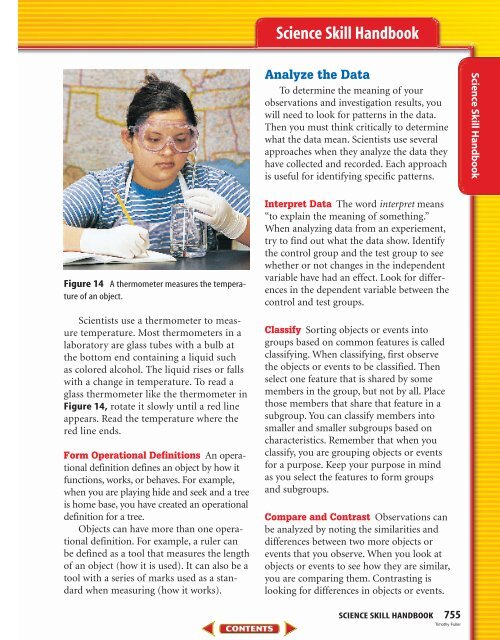Student Resources—746
Student Resources—746
Student Resources—746
Create successful ePaper yourself
Turn your PDF publications into a flip-book with our unique Google optimized e-Paper software.
Figure 14 A thermometer measures the temperature<br />
of an object.<br />
Scientists use a thermometer to measure<br />
temperature. Most thermometers in a<br />
laboratory are glass tubes with a bulb at<br />
the bottom end containing a liquid such<br />
as colored alcohol. The liquid rises or falls<br />
with a change in temperature. To read a<br />
glass thermometer like the thermometer in<br />
Figure 14, rotate it slowly until a red line<br />
appears. Read the temperature where the<br />
red line ends.<br />
Form Operational Definitions An operational<br />
definition defines an object by how it<br />
functions, works, or behaves. For example,<br />
when you are playing hide and seek and a tree<br />
is home base, you have created an operational<br />
definition for a tree.<br />
Objects can have more than one operational<br />
definition. For example, a ruler can<br />
be defined as a tool that measures the length<br />
of an object (how it is used). It can also be a<br />
tool with a series of marks used as a standard<br />
when measuring (how it works).<br />
Science Skill Handbook<br />
Analyze the Data<br />
To determine the meaning of your<br />
observations and investigation results, you<br />
will need to look for patterns in the data.<br />
Then you must think critically to determine<br />
what the data mean. Scientists use several<br />
approaches when they analyze the data they<br />
have collected and recorded. Each approach<br />
is useful for identifying specific patterns.<br />
Interpret Data The word interpret means<br />
“to explain the meaning of something.”<br />
When analyzing data from an experiement,<br />
try to find out what the data show. Identify<br />
the control group and the test group to see<br />
whether or not changes in the independent<br />
variable have had an effect. Look for differences<br />
in the dependent variable between the<br />
control and test groups.<br />
Classify Sorting objects or events into<br />
groups based on common features is called<br />
classifying. When classifying, first observe<br />
the objects or events to be classified. Then<br />
select one feature that is shared by some<br />
members in the group, but not by all. Place<br />
those members that share that feature in a<br />
subgroup. You can classify members into<br />
smaller and smaller subgroups based on<br />
characteristics. Remember that when you<br />
classify, you are grouping objects or events<br />
for a purpose. Keep your purpose in mind<br />
as you select the features to form groups<br />
and subgroups.<br />
Compare and Contrast Observations can<br />
be analyzed by noting the similarities and<br />
differences between two more objects or<br />
events that you observe. When you look at<br />
objects or events to see how they are similar,<br />
you are comparing them. Contrasting is<br />
looking for differences in objects or events.<br />
SCIENCE SKILL HANDBOOK 755<br />
Timothy Fuller<br />
Science Skill Handbook
















